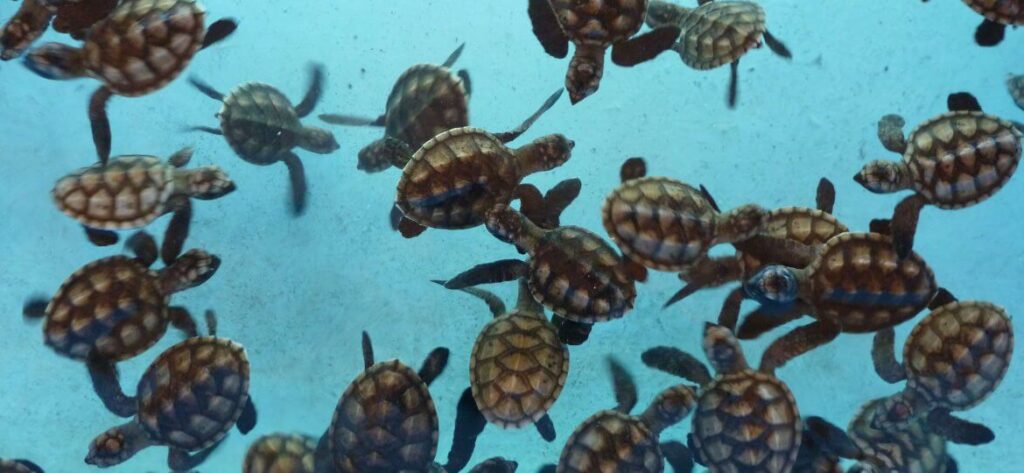Bali, with its picturesque beaches and azure waters, has long been a favorite destination for traveler’s seeking sun, sand, and surf. However, beyond its breathtaking beauty lies a fragile ecosystem that is home to several endangered species, including sea turtles. In this article, we will delve into the crucial world of sea turtle conservation in Bali, exploring the challenges, efforts, and success stories that contribute to the preservation of these majestic marine creatures.
The Importance of Sea Turtles in Bali

Sea turtles, or “penyu” as they are known in Indonesian, hold a special place in the hearts and culture of Bali. These ancient reptiles have existed for over 100 million years, predating many of the planet’s modern species. Bali’s coastal waters are critical nesting and foraging grounds for several species of sea turtles, including the green sea turtle (Chelonia mydas) and the hawksbill sea turtle (Eretmochelys imbricata). These sea turtles play vital roles in the marine ecosystem:
- Ecosystem Health: Sea turtles help maintain the health of coral reefs and seagrass beds by grazing on algae, which can otherwise smother these essential habitats.
- Biodiversity: The eggs and hatchlings of sea turtles provide a crucial food source for various predators, contributing to the biodiversity of Bali’s coastal ecosystems.
- Local Economy: Sea turtles also play a role in the local economy, drawing tourists to participate in responsible turtle conservation programs and activities.
Challenges to Sea Turtle Conservation in Bali
Despite their importance, sea turtles in Bali face numerous challenges that threaten their survival:
- Habitat Destruction: Coastal development, pollution, and climate change have led to habitat loss and degradation, making nesting beaches less suitable for sea turtles.
- Poaching: Sea turtles and their eggs are targets for illegal poaching. Their meat, shells, and eggs are valued in some traditional Balinese ceremonies and can be sold on the black market.
- Bycatch: Sea turtles often become unintentional victims of commercial fishing operations, getting entangled in nets and injured by fishing hooks.
- Light Pollution: Artificial lights along the coast can disorient hatchlings, causing them to become disoriented and wander away from the ocean, which significantly reduces their chances of survival.
Conservation Efforts in Bali
In response to these challenges, various organisations, local communities, and government initiatives have taken action to protect sea turtles in Bali. Here are some of the key conservation efforts:
- Sea Turtle Hatcheries: Bali is home to several sea turtle hatcheries where eggs are collected from vulnerable nests and incubated in a controlled environment. Once hatched, the baby turtles are released into the ocean, increasing their chances of survival.
- Community Engagement: Many coastal communities in Bali have embraced the importance of sea turtle conservation. They actively participate in monitoring nests, protecting hatchlings, and educating tourists and residents alike about the value of sea turtles.
- Research and Monitoring: Scientific research and monitoring programs help track sea turtle populations, nesting patterns, and migration routes, providing valuable data for conservation efforts.
- Marine Protected Areas: Bali has designated several marine protected areas where fishing and other potentially harmful activities are restricted to safeguard sea turtle habitats.
- Tourism and Education: Responsible tourism and educational initiatives raise awareness about sea turtle conservation. Tourists can participate in hatchling releases and learn about the threats facing these creatures.
Success Stories and Encouraging Signs
Despite the challenges, there have been significant successes in sea turtle conservation in Bali:
- Population Recovery: Conservation efforts have led to increased sea turtle populations in some areas. The careful protection of nests and hatchlings has allowed more sea turtles to reach maturity and reproduce.
- Community Empowerment: Local communities have become proactive guardians of sea turtles, recognising the long-term benefits of conservation for their environment and economy.
- Tourist Engagement: Travellers are increasingly seeking responsible tourism experiences that involve sea turtle conservation. Their contributions, both financial and through volunteering, provide essential support for ongoing efforts.
The Role of Responsible Tourism
Responsible tourism plays a crucial role in sea turtle conservation in Bali. Visitors can contribute to these efforts in several ways:
- Choose Responsible Operators: Select tour operators and accommodations that actively support sea turtle conservation and adhere to ethical practices.
- Educate Yourself: Learn about sea turtle conservation in Bali and the challenges these creatures face. Understanding the issues empowers you to make responsible choices.
- Participate in Conservation Activities: If you have the opportunity, join sea turtle hatchling releases, nest monitoring programs, or educational workshops to directly contribute to conservation.
- Support Local Initiatives: Purchase locally-made souvenirs that support community-driven sea turtle conservation projects.
Conclusion: A Future for Sea Turtles in Bali
Sea turtle conservation in Bali is a testament to the power of local communities, governments, and responsible tourism in protecting these magnificent creatures and their fragile habitats. While challenges persist, the collaborative efforts of conservationists, businesses, and individuals are providing hope for the survival of sea turtles in this tropical paradise. As we continue to appreciate Bali’s natural beauty, let us also commit to preserving its underwater wonders, ensuring that sea turtles have a future in this stunning island sanctuary.
UP NEXT
Exploring the Rich Diversity of Ocean Animals in Australia
The Leafy Sea Dragon: Among the Strangest Ocean Creatures



